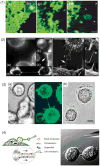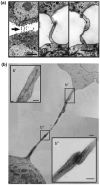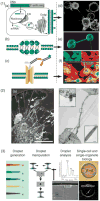Intercellular nanotubes: insights from imaging studies and beyond
- PMID: 20166114
- PMCID: PMC5602582
- DOI: 10.1002/wnan.80
Intercellular nanotubes: insights from imaging studies and beyond
Abstract
Cell-cell communication is critical to the development, maintenance, and function of multicellular organisms. Classical mechanisms for intercellular communication include secretion of molecules into the extracellular space and transport of small molecules through gap junctions. Recent reports suggest that cells also can communicate over long distances via a network of transient intercellular nanotubes. Such nanotubes have been shown to mediate intercellular transfer of organelles as well as membrane components and cytoplasmic molecules. Moreover, intercellular nanotubes have been observed in vivo and have been shown to enhance the transmission of pathogens such as human immunodeficiency virus (HIV)-1 and prions in vitro. These studies indicate that intercellular nanotubes may play a role both in normal physiology and in disease.
Figures









References
-
- Wolpert L, Gustafson T. Studies on the cellular basis of morphogenesis of the sea urchin embryo. The formation of the blastula. Exp Cell Res. 1961;25:374–382. - PubMed
-
- Ramirez-Weber F, Kornberg T. Cytonemes: cellular processes that project to the principal signaling center in Drosophila imaginal discs. Cell. 1999;97:599–607. - PubMed
-
- Miller J, Fraser S, McClay D. Dynamics of thin filopodia during sea urchin gastrulation. Development. 1995;121:2501–2511. - PubMed
-
- Rustom A, Saffrich R, Markovic I, Walther P, GerdesH Nanotubular highways for intercellular organelletransport. Science. 2004;303:1007–1010. - PubMed
-
- Önfelt B, Nedvetzki S, Yanagi K, Davis DM. Cutting edge: membrane nanotubes connect immune cells. J Immunol. 2004;173:1511–1513. - PubMed
Intercellular nanotubes
-
- Sowinski S, Jolly C, Berninghausen O, Purbhoo MA, Chauveau A, Köhler K, Oddos S, Eissmann P, Brodsky FM, Hopkins C, Önfelt B, Sattentau Q, Davis DM. Membrane nanotubes physically connect T cells over long distances presenting a novel route for HIV-1 transmission. Nature Cell Biology. 2008;10:211–219. doi: 10.1038/ncb1682. - DOI - PubMed
Nanotube-Vesicle Networks
HIV and ICNs
-
- Jones S. Cell Biology: Tube travel for HIV? Nature Reviews Microbiology. 2008;6(3):175. doi: 10.1038/nrmicro1866. - DOI
Publication types
MeSH terms
Grants and funding
LinkOut - more resources
Full Text Sources
Miscellaneous

